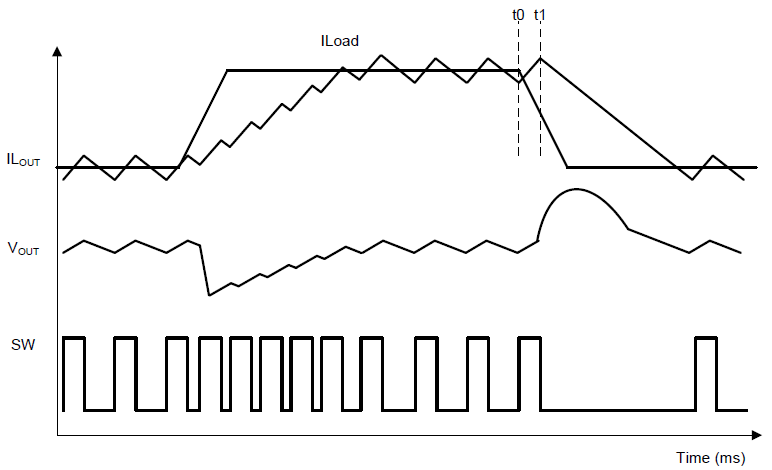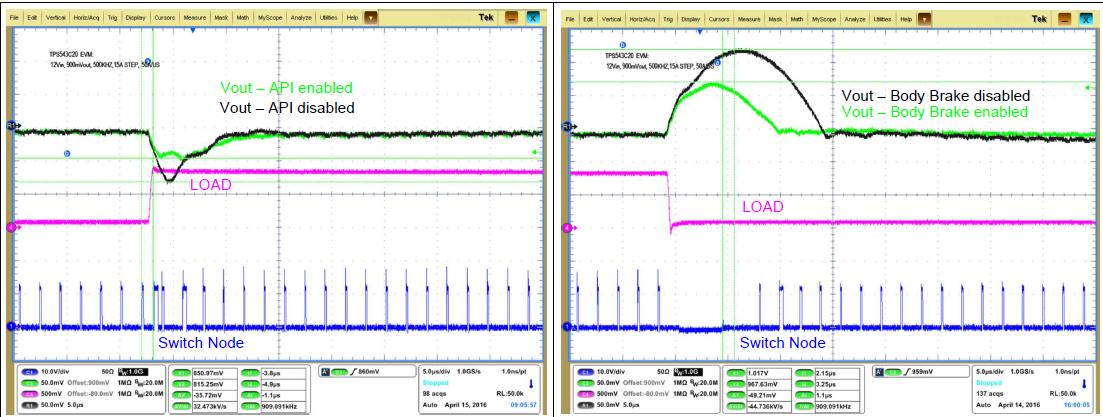SLVAE92A March 2019 – January 2020 TPS51200 , TPS53317A , TPS53513 , TPS53515 , TPS53915 , TPS543B20 , TPS543C20A , TPS54424 , TPS544B20 , TPS546D24 , TPS546D24A , TPS54824 , TPS548A20 , TPS548A28 , TPS548B22 , TPS548B28 , TPS549A20 , TPS549B22 , TPS549D22 , TPS54J061 , TPS62147 , TPS74801
3 Load Transient Response
Since the load profile can change dramatically in an enterprise rack server, it is important to consider AC transient performance. Choosing a DC/DC converter with a fast transient response using non-linear control techniques, such as constant on-time or D-CAP3™, allows a fast transient response with minimal output capacitance. A typical D-CAP3 converter design has three primary considerations for deciding the value of the output capacitance: transient (which includes load step and slew rate of the load step), output ripple, and stability. In applications where the load transient is stringent, the output capacitance is predominantly driven by the transient requirement. Today, a tight ripple requirement is becoming important in some high-end, high-performance application-specific integrated circuit (ASIC) and field-programmable gate array (FPGA) designs. The LC output power stage must be designed to meet the ripple criteria. For a D-CAP3-based design, there is a minimum capacitance requirement in terms of small signal stability. This requirement prevents subharmonic, multiple-pulsing behavior in all D-CAP modulators. Figure 3-1 shows how D-CAP3 control mode works in a load transient case. The Calculating Output Capacitance to Meet Transient and Ripple Requirements of an Integrated POL Converter Design Based on D-CAPx™ Modulators application report shows how to design the output filter for a 1-V output to accommodate a ±10 mV ripple requirement and a ±30 mV transient voltage deviation using the D-CAP3 control mode.
 Figure 3-1 Load Transient Response of a D-CAP3 Converter
Figure 3-1 Load Transient Response of a D-CAP3 ConverterThe TPS543C20A converter features a new control mode called Advanced Current Mode (ACM), which is an internally compensated emulated peak-current-mode control with a clock synchronizable, fixed-frequency modulator. The internal integrator and directly amplifying ramp tracking loop eliminates the need for external compensation over a wide range of frequencies. The TPS543C20A also features Asynchronous Pulse Injection (API) and body braking to improve transient performance by significantly reducing undershoot and overshoot, respectively, reducing the external capacitance requirement. When the API and body diode braking are activated, ACM delivers a similar transient performance as D-CAP3. Figure 3-2 shows examples of undershoot and overshoot reduction with API and body braking. (2)
 Figure 3-2 Asynchronous Pulse Injection and Body Braking
Figure 3-2 Asynchronous Pulse Injection and Body Braking